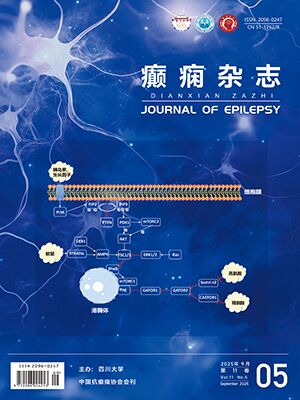| 1. |
Yuen AWC, Keezer MR, Sander JW. Epilepsy is a neurological and a systemic disorder. Epilepsy Behav, 2018, 78: 57-61.
|
| 2. |
Musto E, Gardella E, Møller RS. Recent advances in treatment of epilepsy-related sodium channelopathies. Eur J Paediatr Neurol, 2020, 24: 123-128.
|
| 3. |
Han S, Yu FH, Schwartz MD, et al. Na(V)1.1 channels are critical for intercellular communication in the suprachiasmatic nucleus and for normal circadian rhythms. Proc Natl Acad Sci U S A, 2012, 109(6): E368-E377.
|
| 4. |
张慧敏, 田欢, 张晶钰. 钠离子通道在神经性疾病发病机制的研究进展. 基因组学与应用生物学, 2020, 38(1): 1-13.
|
| 5. |
Wallace E, Wright S, Schoenike B, et al. Altered circadian rhythms and oscillation of clock genes and sirtuin 1 in a model of sudden unexpected death in epilepsy. Epilepsia, 2018, 59(8): 1527-1539.
|
| 6. |
Wei F, Yan LM, Su T, et al. Ion channel genes and epilepsy: functional alteration, pathogenic potential, and mechanism of epilepsy. Neurosci Bull, 2017, 33(4): 455-477.
|
| 7. |
Deng Chen, Yang Si, Jun He, et al. Terminal seizure frequency and its relation to SUDEP. Epilepsy Behav, 2017, 70(Pt A): 173-176.
|
| 8. |
Köhling R, Wolfart J. Potassium channels in epilepsy. Cold Spring Harb Perspect Med, 2016, 6(5): a022871.
|
| 9. |
Rajakulendran S, Hanna MG. The role of calcium channels in epilepsy. Cold Spring Harb Perspect Med, 2016, 6(1): a022723.
|
| 10. |
Cheong E, Shin HS. T-type Ca2+ channels in normal and abnormal brain functions. Physiol Rev, 2013, 93(3): 961-992.
|
| 11. |
Tillman L, Zhang J. Crossing the chloride channel: the current and potential therapeutic value of the neuronal K+-Cl- Cotransporter KCC2. Biomed Res Int, 2019, 25(12): 8941046.
|
| 12. |
Murillo-Rodriguez E, Arias-Carrion O, Zavala-Garcia A, et al. Basic sleep mechanisms: an integrative review. Cent Nerv Syst Agents Med Chem, 2012, 12(1): 38-54.
|
| 13. |
Brown RE, Basheer R, McKenna JT, et al. Control of sleep and wakefulness. Physiol Rev, 2012, 92(3): 1087-1187.
|
| 14. |
Verkhratsky A, Ho MS, Zorec R, et al. The concept of neuroglia. Adv Exp Med Biol, 2019, 1175: 1-13.
|
| 15. |
Filous AR, Silver J. Targeting astrocytes in CNS injury and disease: A translational research approach. Prog Neurobiol, 2016, 144: 173-187.
|
| 16. |
Pellerin L, Magistretti PJ. Sweet sixteen for ANLS. J Cereb Blood Flow Metab, 2012, 32(7): 1152-1166.
|
| 17. |
陈忠, 孙红柳. 星形胶质细胞在癫痫发病中的作用. 浙江大学学报(医学版), 2013, 42(3): 245-252.
|
| 18. |
Lazarus M, Chen JF, Huang ZL, et al. Adenosine and sleep. Handb Exp Pharmacol, 2019, 253: 359-381.
|
| 19. |
Boison D, Steinhäuser C. Epilepsy and astrocyte energy metabolism. Glia, 2018, 66(6): 1235-1243.
|
| 20. |
Eid T, Gruenbaum SE., Dhaher R., et al The glutamate–glutamine cycle in epilepsy. Adv Neurobiol, 2016, 13: 351-400.
|
| 21. |
彭毓棻, 宋治. NMDA受体在癫痫发病机制中的作用. 中国病理生理杂志, 2011, 27(06): 1230-1233+1239.
|
| 22. |
于欢, 洪震. 癫痫患者的认知功能障碍. 中国临床康复, 2004, 10(22): 4586-4588.
|
| 23. |
Zhu S, Noviello CM, Teng J, et al. Structure of a human synaptic GABAA receptor. Nature, 2018, 559(7712): 67-72.
|
| 24. |
Helmstaedter C, Witt JA. Epilepsy and cognition – A bidirectional relationship? Seizure, 2017, 49: 83-89.
|
| 25. |
Janati AB, ALGhasab NS, Aldaife MY, et al. A typical interictal epileptiform discharges in electroencephalography. J Epilepsy Res, 2018, 8(2): 55-60.
|
| 26. |
Braun KPJ. Preventing cognitive impairment in children with epilepsy. Current Opinion in Neurology, 2017, 30(2): 140-147.
|
| 27. |
Liu XY., Shi T, Yin WN, et al Interictal epileptiform discharges were associated with poorer cognitive performance in adult epileptic patients. Epilepsy Research, 2016, 128: 1-5.
|
| 28. |
Gelinas JN, Khodagholy D, Thesen T, et al. Interictal epileptiform discharges induce hippocampal-cortical coupling in temporal lobe epilepsy. Nat Med, 2016, 22(6): 641-648.
|
| 29. |
Horak PC, Meisenhelter S, Song Y, et al. Interictal epileptiform discharges impair word recall in multiple brain areas. Epilepsia, 2017, 58(3): 373-380.
|
| 30. |
Becker AJ. Review: Animal models of acquired epilepsy: insights into mechanisms of human epileptogenesis. Neuropathology and Applied Neurobiology, 2018, 44(1): 112-129.
|
| 31. |
Eastman CL, D'Ambrosio R, Ganesh T. Modulating neuroinflammation and oxidative stress to prevent epilepsy and improve outcomes after traumatic brain injury. Neuropharmacology, 2020, 172: 107907.
|
| 32. |
陈美丽, 白宇. 癫痫与认知功能关系的研究进展. 中国康复理论与实践, 2012, 18(4): 341-343.
|
| 33. |
Löscher W, Friedman A. Structural, molecular, and functional alterations of the blood-brain barrier during epileptogenesis and epilepsy: A cause, consequence, or both? Int J Mol Sci, 2020, 21(2): 591.
|
| 34. |
Prager O, Kamintsky L, Hasam-Henderson LA, et al. Seizure-induced microvascular injury is associated with impaired neurovascular coupling and blood-brain barrier dysfunction. Epilepsia, 2019, 60(2): 322-336.
|
| 35. |
Wang L, Chen S, Liu C, et al. Factors for cognitive impairment in adult epileptic patients. Brain Behav, 2020, 10(1): e01475.
|
| 36. |
Kataria, L., & Vaughn, B. V Sleep and epilepsy. Sleep Medicine Clinics, 2016, 11(1): 25-38.
|
| 37. |
Bazil, C. Sleep and epilepsy. Seminars in Neurology, 2017, 37(04): 407-412.
|
| 38. |
Wennberg AMV, Wu MN, Rosenberg PB, et al. Sleep disturbance, cognitive decline, and dementia: a review. Semin Neurol, 2017, 37(4): 395-406.
|
| 39. |
Lanigar S, Bandyopadhyay S. Sleep and epilepsy: a complex interplay. Mo Med, 2017, 114(6): 453-457.
|




